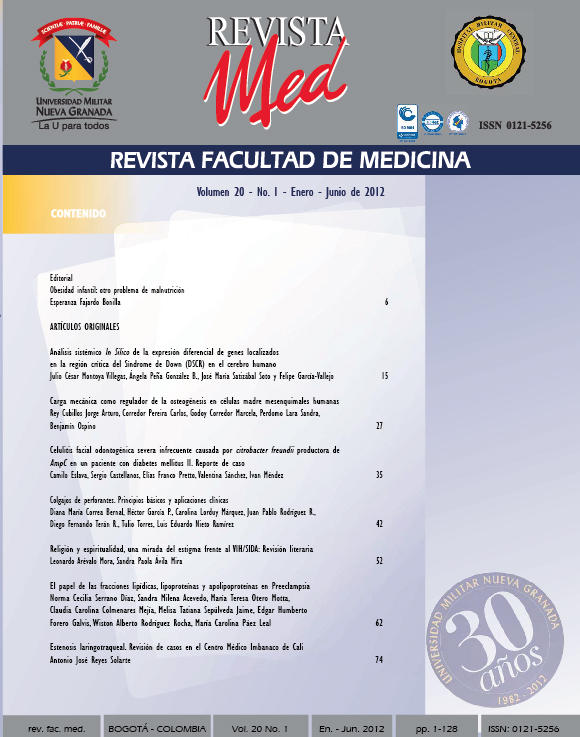El papel de las fracciones lipídicas, lipoproteínas y apolipoproteínas en Preeclampsia
Resumen
La Preeclampsia (PE) es un trastorno multisistémico, exclusivo de la gestación humana y responsable de aproximadamente 44.000 muertes maternas anuales a nivel mundial; esta enfermedad está asociada a múltiples complicaciones tanto en la madre como en el feto, sin embargo, su etiología no se encuentra totalmente dilucidada y en consecuencia ha sido difícil definir estrategias válidas de predicción. La PE es una enfermedad compleja y comparte diferentes factores de riesgo con las enfermedades cardiovasculares; como la obesidad, hipertensión arterial, resistencia a la insulina y dislipidemias. Con esto se evidencia que algunas alteraciones en los niveles lípidos y apolipoproteínas, se asocian con mayor peroxidación lipídica y estrés oxidativo lo cual puede desencadenar en disfunción endotelial para ambas patologías. Por tanto, la exploración de la evidencia de una asociación entre las fracciones lipídicas y riesgo de PE, puede aportar nuevo conocimiento en torno a la etiología de esta enfermedad. En la presente revisión, se plantearán las principales implicaciones biológicas de las alteraciones del perfil lipídico y apolipoproteínas en la génesis de la PE. Se describirán los estudios observacionales que se han aproximado a su evaluación y se identificarán sus principales debilidades metodológicas, con el fin de plantear estrategias para una evaluación integral de esta vía fisiopatológica, con posibles implicaciones predictivas de la enfermedad.
Descargas
Lenguajes:
esReferencias bibliográficas
World Health Organization International Collaborative Study of Hypertensive Disorders of Pregnancy. Geographic Variation in the incidence of hypertension in pregnancy. Am J Obstet Gynecol. 1998; 158(1): 80-83.
Khan K, Wojdyla D, Say L, Gülmezoglu A, Van Look P. WHO analysis of causes of maternal death: a systematic review. Lancet. 2006; 367(9516):1066–1074.
Garovic V, Baileyb K, Boerwinklec E, Huntd S, Wedere A, et al. Hypertension in pregnancy as a risk factor for cardiovascular disease later in life. J Hypertens. 2010; 28(4): 826–833.
Girouard J, Giguère Y, Moutquin J, and Forest J. Previous Hypertensive Disease of Pregnancy Is Associated With Alterations of Markers of Insulin Resistance. Hypertension. 2007; 49(5): 1056-1062.
Roberts J, Gammill H. Insulin Resistance in Preeclampsia. Hypertension. 2006; 47(3): 341-342.
Poston L. Endothelial dysfunction in pre-eclampsia. Pharmacol Rep. 2006; 58Suppl: 69-74.
Zavalza-Gómez AB. Obesity and oxidative stress: a direct link to preeclampsia? Arch Gynecol Obstet. 2011; 283(3): 415-422.
Redman CWG, Sargent IL. Placental debris, oxidative stress and preeclampsia. Placenta.2000; 21(7): 597–602.
Sibai B, Dekker G, Kupferminc M. Pre-eclampsia. Lancet. 2005; 365(9461): 785-799.
Savvidou MD, Hingorani AD, Tsikas D, Frolich JC, Vallance P, Nicolaides KH. Endothelial dysfunction and raised plasma concentrations of asymmetric dimethylarginine in pregnant women who subsequently develop pre-eclampsia. Lancet. 2003; 361(9368): 1511-1517.
Murphy BP, Stanton T, Dunn FG. Hypertension and myocardial ischemia. Med Clin North Am. 2009; 93(3): 681-695.
Cnossen JS, Leeflang MM, de Haan EE, Mol BW, van der Post JA, Khan KS, et al. Accuracy of body mass index in predicting pre-eclampsia: bivariate meta-analysis. BJOG. 2007; 114(12): 1477-1485.
Berg LH. Lipid measurements for coronary risk assessment: a review. Am J Med Technol. 1981; 47(7): 539-543.
Francis KT. HDL cholesterol and coronary heart disease. South Med J. 1980; 73(2): 169-173.
Davignon J, Gregg RE, Sing CF. Apolipoprotein E polymorphism and atherosclerosis. Arteriosclerosis. 1988; 8(1): 1-21.
Prospective Studies Collaboration, Lewington S, Whitlock G, Clarke R, Sherliker P, Emberson J, Halsey J, et al. Blood cholesterol and vascular mortality by age, sex, and blood pressure: a meta-analysis of individual data from 61 prospective studies with 55,000 vascular deaths. Lancet. 2007; 372(9635): 1829-1839.
Enquobahrie DA, Williams MA, Butler CL, Frederick IO, Miller RS, Luthy DA. Maternal plasma lipid concentrations in early pregnancy and risk of preeclampsia. Am J Hypertens. 2004; 17(7): 574-581.
Belo L, Caslake M, Gaffney D, Santos-Silva A, Pereira-Leite L, Quintanilha A, et al. Changes in LDL size and HDL concentration in normal and preeclamptic pregnancies. Atherosclerosis. 2002; 162(2): 425-432. 19. Bayhan G, Koçyigit Y, Atamer A, Atamer Y, Akkus Z. Potential atherogenic roles of lipids, lipoprotein(a) and lipid peroxidation in preeclampsia. GynecolEndocrinol. 2005; 21(1): 1-6.
Koçyigit Y, Atamer Y, Atamer A, Tuzcu A, Akkus Z. Changes in serum levels of leptin, cytokines and lipoprotein in preeclamptic and normotensive pregnant women. GynecolEndocrinol. 2004;19(5): 267-273.
Rodie VA, Caslake MJ, Stewart F, Sattar N, Ramsay JE, Greer IA, Freeman DJ. Fetal cord plasma lipoprotein status in uncomplicated human pregnancies and in pregnancies com- plicated by pre-eclampsia and intrauterine growth restriction. Atherosclerosis. 2004; 176(1): 181-187.
Barden AE, Beilin LJ, Ritchie J, Walters BN, Michael C. Does a predisposition to the metabolic syndrome sensitize women to develop pre-eclampsia? J Hypertens. 1999; 17(9): 1307-1315.
Wakatsuki A, Ikenoue N, Okatani Y, Shinohara K, Fukaya T. Lipoprotein particles in preeclampsia: susceptibility to oxidative modification. Obstet Gynecol. 2000; 96(1): 55-59.
Raijmakers MT, van Tits BJ, Hak-Lemmers HL, Roes EM, Steegers EA, Peters WH. Low plasma levels of oxidized low density lipoprotein in preeclampsia. Acta Obstet Gynecol Scand. 2004; 83(12): 1173-1177.
Vanderjagt DJ, Patel RJ, El-Nafaty AU, Melah GS, Crossey MJ, Glew RH. High-density lipoprotein and homocysteine levels correlate inversely in preeclamptic women in northern Nigeria. ActaObstetGynecol Scand. 2004; 83(6): 536-542.
Ware-Jauregui S, Sanchez SE, Zhang C, Laraburre G, King IB, Williams MA. Plasma lipid concentrations in pre-eclamptic and normotensive Peruvian women. Int J Gynaecol Obstet. 1999; 67(3): 147-155.
Powers RW, Evans RW, Majors AK, Ojimba JI, Ness RB, Crombleholme WR, Roberts JM. Plasma homocysteine concentration is increased in preeclampsia and is associated with evidence of endothelial activation. Am J Obstet Gynecol. 1998; 179(6 PT 1): 1605-1611.
Vadachkoria S, Woelk GB, Mahomed K, Qiu C, Muy-Rivera M, Malinow MR, Williams MA. Elevated soluble vascular cell adhesion molecule-1, elevated Homocyst(e)inemia, and hypertriglyceridemia in relation to preeclampsia risk. Am J Hypertens. 2006; 19(3): 235-242.
Clausen T, Djurovic S, Henriksen T. Dyslipidemia in early second trimester is mainly a feature of women with early onset pre-eclampsia. BJOG. 2001; 108(10): 1081-1087.
Kaaja R, Tikkanen MJ, Viinikka L, Ylikorkala O. Serum lipoproteins, insulin, and urinary prostanoid metabolites in normal and hypertensive pregnant women. Obstet Gynecol. 1995; 85(3): 353-356.
Maseki M, Nishigaki I, Hagihara M, Tomoda Y, Yagi K. Lipid peroxide levels and lipids content of serum lipoprotein fractions of pregnant subjects with or without pre-eclampsia. ClinChimActa. 1981; 115(2): 155-161.
Gratacós E, Casals E, Sanllehy C, Cararach V, Alonso PL, Fortuny A. Variation in lipid levels during pregnancy in women with different types of hypertension. ActaObstetGynecol Scand. 1996; 75(10):896-901. 33. Williams MA, Woelk GB, King IB, Jenkins L, Mahomed K. Plasma carotenoids, retinol, tocopherols, and lipoproteins in preeclamptic and normotensive pregnant Zimbabwean women. Am J Hypertens. 2003; 16(8):665-672.
Murai JT, Muzykanskiy E, Taylor RN. Maternal and fetal modulators of lipid metabolism correlate with the development of preeclampsia. Metabolism. 1997; 46(8):963-967.
Baker AM, Klein RL, Moss KL, Haeri S, Boggess K. Maternal serum dyslipidemia occurs early in pregnancy in women with mild but not severe preeclampsia. Am J Obstet Gynecol. 2009; 201(3): 293.e1-4.
Mayret-Mesquiti M, Pérez-Méndez O, Rodríguez ME, Fortoul TI, Gorocica P, Bernal-Alcántara D, Montaño LF, Alvarado- Vasquez N. Hypertriglyceridemia is linked to reduced nitric oxide synthesis in women with hypertensive disorders of pregnancy. Hypertens Pregnancy. 2007; 26(4): 423-431.
Franz H, Wendler D. A controlled study of maternal serum concentrations of lipoproteins in pregnancy-induced hypertension. Arch Gynecol Obstet. 1992; 252(2): 81-86.
Llurba E, Casals E, Domínguez C, Delgado J, Mercadé I, Crispi F, Martín-Gallán P, Cabero L, Gratacós E. Atherogenic lipoprotein subfraction profile in preeclamptic women with and without high triglycerides: different pathophysiologic subsets in preeclampsia. Metabolism. 2005; 54(11): 1504-1509.
Oqura K, Miyatake T, Fukui O, Nakamura T, Kameda T, Yoshino G. Low-density lipoprotein particle diameter in normal pregnancy and preeclampsia. J AtherosclerThromb. 2002; 9(1): 42-47.
Hubel CA, Lyall F, Weissfeld L, Gandley RE, Roberts JM. Small low-density lipoproteins and vascular cell adhesion molecule-1 are increased in association with hyperlipidemia in preeclampsia. Metabolism. 1998; 47(10): 1281-1288.
Catarino C, Rebelo I, Belo L, Rocha-Pereira P, Rocha S, Castro EB, Patrício B, Quintanilha A, Santos-Silva A. Fetal lipoprotein changes in pre-eclampsia. Acta Obstet Gynecol Scand. 2008; 87(6): 628-634.
Yamaguchi K. Triglycerides and apoproteins in toxemia of pregnancy. Nihon SankaFujinkaGakkaiZasshi. 1988; 40(12): 1875-1882.
Sanchez SE, Zhang C, Williams MA. The influence of maternal triglyceride levels on infant birth weight in Peruvian women with pre-eclampsia. J Matern Fetal Neonatal Med. 2003; 13(5): 328-333.
Mikhail MS, Basu J, Palan PR, Furgiuele J, Romney SL, Anyaegbunam A. Lipid profile in women with preeclampsia:relationship between plasma triglyceride levels and severity of preeclampsia. J Assoc Acad Minor Phys. 1995; 6(1): 43-45.
Magnussen EB, Vatten LJ, Lund-Nilsen TI, Salvesen KA, Davey Smith G, Romundstad PR. Prepregnancy cardiovascular risk factors as predictors of pre-eclampsia: population based cohort study. BMJ. 2007; 10; 335(7627): 978.
McQueen MJ, Hawken S, Wang X, Ounpuu S, Sniderman A, Probstfield J, Steyn K, Sanderson JE, Hasani M, Volkova E, Kazmi K, Yusuf S; INTERHEART study investigators. Lipids, lipoproteins, and apolipoproteins as risk markers of myocardial infarction in 52 countries (the INTERHEART study): a case-control study. Lancet. 2008 19; 372(9634): 224-233.
Zhang H, Zhang Y, Yang F, Li L, Liu S, Xu Z, Wang J, Sun S. Complement component C4A and apolipoprotein A-I in plasmas as biomarkers of the severe, early-onset preeclampsia. Mol Biosyst. 2011; 7(8): 2470-2479.
Koçyigit Y, Atamer Y, Atamer A, Tuzcu A, Akkus Z. Changes in serum levels of leptin, cytokines and lipoprotein in preeclamptic and normotensive pregnant women. Gynecol Endocrinol. 2004; 19(5): 267-273.
Belo L, Gaffney D, Caslake M, Santos-Silva A, Pereira-Leite L, Quintanilha A, Rebelo I. Apolipoprotein E and cholesteryl ester transfer protein polymorphisms in normal and preeclamptic pregnancies. Eur J Obstet Gynecol Reprod Biol. 2004; 112(1): 9-15.
Var A, Kucu NK, Koyuncu F, Uyanik BS, Onur E, Yildirim Y, Oruç S. Atherogenic profile in preeclampsia. Arch Gynecol Obstet. 2003; 268(1): 45-47.
Hayman RG, Sattar N, Warren AY, Greer I, Johnson IR, Baker PN. Relationship between myometrial resistance artery behavior and circulating lipid composition. Am J Obstet Gynecol. 1999; 180(2 Pt 1): 381-386.
Kobayashi S, Tanaka M, Masaki K, Hirakawa S, Momose K. Apolipoprotein levels in preeclamptic pregnancies. Nihon SankaFujinkaGakkaiZasshi. 1992; 44(2): 223-228.
Rosing U, Samsioe G, Olund A, Johansson B, Kallner A. Serum levels of apolipoprotein A-I, A-II and HDL-cholesterol in second half of normal pregnancy and in pregnancy complicated by pre-eclampsia. HormMetab Res. 1989; 21(7):376-382
Demir B, Demir S, Atamer Y, Guven S, Atamer A, Kocyigit Y, Hekimoglu A, Toprak G. Serum levels of lipids, lipoproteins and paraoxonase activity in pre-eclampsia. J Int Med Res. 2011; 39(4): 1427-1431.
Lei Q, Lv LJ, Zhang BY, Wen JY, Liu GC, Lin XH, Niu JM. Ante-partum and post-partum markers of metabolic syndrome in pre-eclampsia. J Hum Hypertens. 2011; 25(1): 11-17.
Sarandöl E, Safak O, Dirican M, Uncu G. Oxidizability of apolipoprotein B-containing lipoproteins and serum paraoxonase/ arylesterase activities in preeclampsia. ClinBiochem. 2004; 37(11): 990-996.
Cekmen MB, Erbagci AB, Balat A, Duman C, Maral H, Ergen K, Ozden M, Balat O, Kuskay S. Plasma lipid and lipoprotein concentrations in pregnancy induced hypertension. ClinBiochem. 2003; 36(7): 575-578.
Winkler K, Wetzka B, Hoffmann MM, Friedrich I, Kinner M, Baumstark MW, Zahradnik HP, Wieland H, März W. Triglyceride- rich lipoproteins are associated with hypertension in preeclampsia. J ClinEndocrinolMetab. 2003; 88(3): 1162-1666.
Bai H, Liu X, Liu R, Liu Y, Li M, Liu B. Analysis of serum lipid and apolipoprotein levels in pregnancy-induced hypertension and normotensive pregnant women. Hua Xi Yi Ke Da XueXueBao. 2002; 33(1): 58-61.
Bartha JL, Comino-Delgado R, Bedoya FJ, Barahona M, Lubian D, Garcia-Benasach F. Maternal serum nitric oxide levels associated with biochemical and clinical parameters in hypertension in pregnancy. Eur J ObstetGynecolReprod Biol. 1999; 82(2): 201-207.
Chalas J, Audibert F, Francoual J, Le Bihan B, Frydman R, Lindenbaum A. Concentrations of apolipoproteins E, C2, and C3 and lipid profile in preeclampsia. Hypertens Pregnancy. 2002; 21(3): 199-204.
Carty D, Delles C, Dominiczak A. Novel Biomarkers for Predicting Preeclampsia. Trends Cardiovasc Med. 2008; 18(5): 186–194.
Nagy B, Rigo J, Fintor L, Romics L, Papp Z, et al. Distribution of Apolipoprotein(a) Isoforms in Normotensive and Severe Preeclamptic Women. J Matern Fetal Med 1999; 8(6):270–274.
Henriksen T. The role of lipid oxidation and lipid oxidative derivatives in the development of preeclampsia. SeminPerinatol. 2000; 24(1): 29-32.
Atamer Y, Koçyigit Y, Yokus B, Atamer A, Erden AC. Lipid peroxidation, antioxidant defense, status of trace metals and leptin levels in preeclampsia. Eur J ObstetGynecolReprod Biol. 2005; 119(1):60-66.
Raijmakers MT, Peters WH, Steegers EA, Poston L. NAD(P)H oxidase associated superoxide production in human placenta from normotensive and pre-eclamptic women. Placenta. 2004; Suppl A: S85-89.
Dowhan W, Bodanov H. Functional roles of lipids in membranes. Biochemistry of Lipids, Lipoproteins and Membranes, 4th ed. Vance DE, Vance JE, editors. Elsevier; 2002.
Murray RK, Granner DK, Rodwell VW. Lipids of physiologic significance. Harper’s illustrated biochemistry. 27th ed. Papadakis MA, Mcphee SJ,editores. McGraw-Hill Companies, Inc.; 2006.
Gratacos E, Asals E, Nllehy A, Cararach V, Alonso P et al. Variation in lipid levels during pregnancy in women with different types of hypertension. ActaObsteGynecol Scand 1996; 75(10): 896-901.
Takacs P, Kauma S, Sholley M, Walsh S, Dinsmoor J , Green K. Increased circulating lipid peroxides in severe preeclampsia activate NF-κB and upregulate ICAM-1 in vascular endothelial cells. The FASEB. 2001; 15(2):279-281.
Hubel C. Oxidative stress in pathogenesis of preeclampsia. Proc Soc Exp Biol Med. 1999;222(3): 222-235.
McQueen MJ, Hawken S, Wang X, Ounpuu S, Sniderman A, Probstfield J. Lipids, lipoproteins, and apolipoproteins as risk markers of myocardial infarction in 52 countries (the INTERHEART study): a case-control study. Lancet. 2008; 372(9634): 224-233
Bennet AM, Di Angelantonio E, Ye Z, Wensley F, Dahlin A, Ahlbom A, et al. Association of apolipoprotein E genotypes with lipid levels and coronary risk. JAMA. 2007; 298(11): 1300-1311.
Davey Smith G, Ebrahim S. ‘Mendelian randomization’: can genetic epidemiology contribute to understanding environmental determinants of disease? Int J Epidemiol. 2003; 32(1): 1-22
Keavney B. Genetic epidemiological studies of coronary heart disease. Int J Epidemiol. 2002; 31(4):730-736.
Smith GD, Phillips AN. Confounding in epidemiological studies: why “independent” effects may not be all they seem. BMJ. 1992; 305(6836): 757-759.
Bellamy L, Casas JP, Hingorani AD, Williams DJ. Preeclampsia and the risk of cardiovascular disease and cancer in later life: a systematic review and meta-analysis. BMJ. 2007; 335(7627): 974.
Morgan TH. Heredity and sex. New York:Columbia University Press;1913: 27.
Davey Smith G, Ebrahim S. ‘Mendelian randomization’: can genetic epidemiology contribute to understanding environmental determinants of disease? Int J Epidemiol. 2003; 32(1):1-22.
Keavney B. Genetic epidemiological studies of coronary heart disease. Int J Epidemiol. 2002; 31(4): 730-736.
Colhoun HM, McKeigue PM, Davey Smith G. Problems of reporting genetic associations with complex outcomes. Lancet 2003; 361(9360): 865-872
Smith GD, Ebrahim S. Mendelian randomization: prospects, potentials, and limitations. Int J Epidemiol 2004; 33(1): 30-42.
Hingorani A, Humphries S. Nature’s randomised trials. Lancet. 2005; 366(9501): 1906-1908.
Casas JP, Bautista LE, Smeeth L, Sharma P, Hingorani AD. Homocysteine and stroke: evidence on a causal link from mendelian randomization. Lancet 2005; 365(9455): 224-232.
Klerk M, Verhoef P, Clarke R, Blom HJ, Kok FJ, Schouten EG; MTHFR Studies Collaboration Group. MTHFR 677C-->T polymorphism and risk of coronary heart disease: a metaanalysis. JAMA 2002; 288(16): 2023-2031. 86. Casas JP, Shah T, Cooper J, Hawe E, McMahon AD, Gaffney D et al. Insight into the nature of the CRP-coronary event association using Mendelian randomization. Int J Epidemiol. 2006; 35(4): 922-931.
Hingorani AD, Shah T, Casas JP. Linking observational and genetic approaches to determine the role of C-reactive protein in heart disease risk. Eur Heart J. 2006; 27(11):1331-1337.
Brunner EJ, Kivimäki M, Witte DR, Lawlor DA, Davey Smith G, Cooper JA, et al. Inflammation, insulin resistance, and diabetes - Mendelian randomization using CRP haplotypes points upstream. PLoS Med. 2008; 12(5): e155.







.png)





